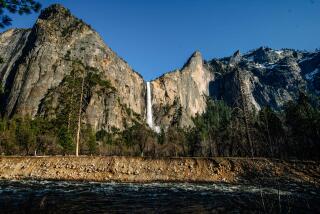Body Found in Glacier May Be of Airman Killed in 1942
- Share via
Investigators in Kings Canyon National Park on Wednesday painstakingly chipped away at a mountain glacier that holds what they suspect are the remains of an airman killed on a training flight that crashed in 1942. Discovered Sunday by a pair of climbers, the icebound body has an unopened parachute strapped to its back, the covering stenciled with the word “Army.”
“They just saw a portion of the body -- head, shoulder and part of an arm -- coming out of a solid block of ice,” said Jody Lyle, a park spokeswoman.
The remains on 13,710-foot Mt. Mendel are hundreds of feet below the summit in a spot known for some of the most difficult climbs in the Sierra. In the same area, a hiker in 1947 found scattered wreckage -- along with four bodies -- from an Army Air Forces AT-7 training plane that had disappeared five years earlier, Lyle said.
While the body may have rested in frozen silence for nearly 63 years, its discovery sent authorities scrambling in a grim drill that occurs with surprising frequency.
Suspected remains of World War II veterans are reported to the government’s Joint POW-MIA Accounting Command at least a dozen times yearly, said officials of the agency, which is in charge of retrieving and identifying the bodies of missing troops. Scientists at the agency’s lab in Hawaii are even working to identify what they believe are the remains of a U.S. soldier from World War I, said Robert Mann, the lab’s deputy director.
One of the lab’s 31 forensic anthropologists flew to California Wednesday morning, joining a team of about five mountaineering park rangers who descended on the remote glacier by helicopter. Equipped to spend the night in subfreezing temperatures, they hoped to be done by morning, park officials said.
When the remains are finally freed, they will be transported to the Fresno County coroner’s office. It was unclear whether an autopsy would be performed there before investigators begin the laborious process of identifying the airman, locating his closest surviving relatives, and arranging for his burial.
“It’s a noble undertaking,” Mann said. “It’s something that should be done.”
After the climbers’ discovery on Sunday, park rangers flying to the site were turned back by foul weather. They finally reached it Tuesday.
Meanwhile, researchers at the park turned up reports on the 1947 discovery by a Sierra Club hiker. Evidently veering far off course on Nov. 18, 1942, the training plane reportedly was based at an airfield in Sacramento and was supposed to head north to the small town of Corning. It never arrived.
“There were numerous plane crashes in these parks and all up and down the Sierra Nevada,” Lyle said. “There were a lot of military training centers in the Central Valley.”
These days, it’s rare for old military crash sites to be spotted in the mainland United States. The bulk of such reports come from Papua New Guinea, where hundreds of U.S. planes were shot down in World War II, said Larry Greer, a spokesman for the Pentagon’s POW/Missing Personnel Office.
Hundreds of planes also disappeared in territory at least as frigid as the upper reaches of Mt. Mendel while navigating “over the hump” of the treacherous mountain ranges between India and China. The Defense Department’s forensics lab recently recovered remains from Tibet and also has extracted remains from a glacier in Greenland, Mann said.
Bodies partially preserved by cold temperatures can be easier to identify, he said, but much of the lab’s sleuthing is facilitated by dental records. Sometimes evidence such as dog tags and ID bracelets are found at the scene. In the more extreme cases, virtual genealogies are compiled and relatives on the mother’s side have to be located for DNA testing.
Once the identities are established, families may opt for burial at Arlington National Cemetery in Virginia.
That’s where Staff Sgt. James D. Cartwright is bound on Nov. 3.
Cartwright’s relatives in Los Angeles were recently told that the long-lost airman was positively identified after DNA tests. His remains were found in wreckage on a jungle mountainside in Panama, where his plane had been missing since 1941.
Cartwright’s nephew, 70-year-old Russell Cartwright, said he was “flabbergasted” by the government’s effort in tracking down the family.
“They told me that anyone willing to die for their country deserves whatever we can give them,” said Cartwright, who will attend the Arlington ceremony at the government’s expense. “There’s a lot to be said for that.”
More to Read
Sign up for Essential California
The most important California stories and recommendations in your inbox every morning.
You may occasionally receive promotional content from the Los Angeles Times.











